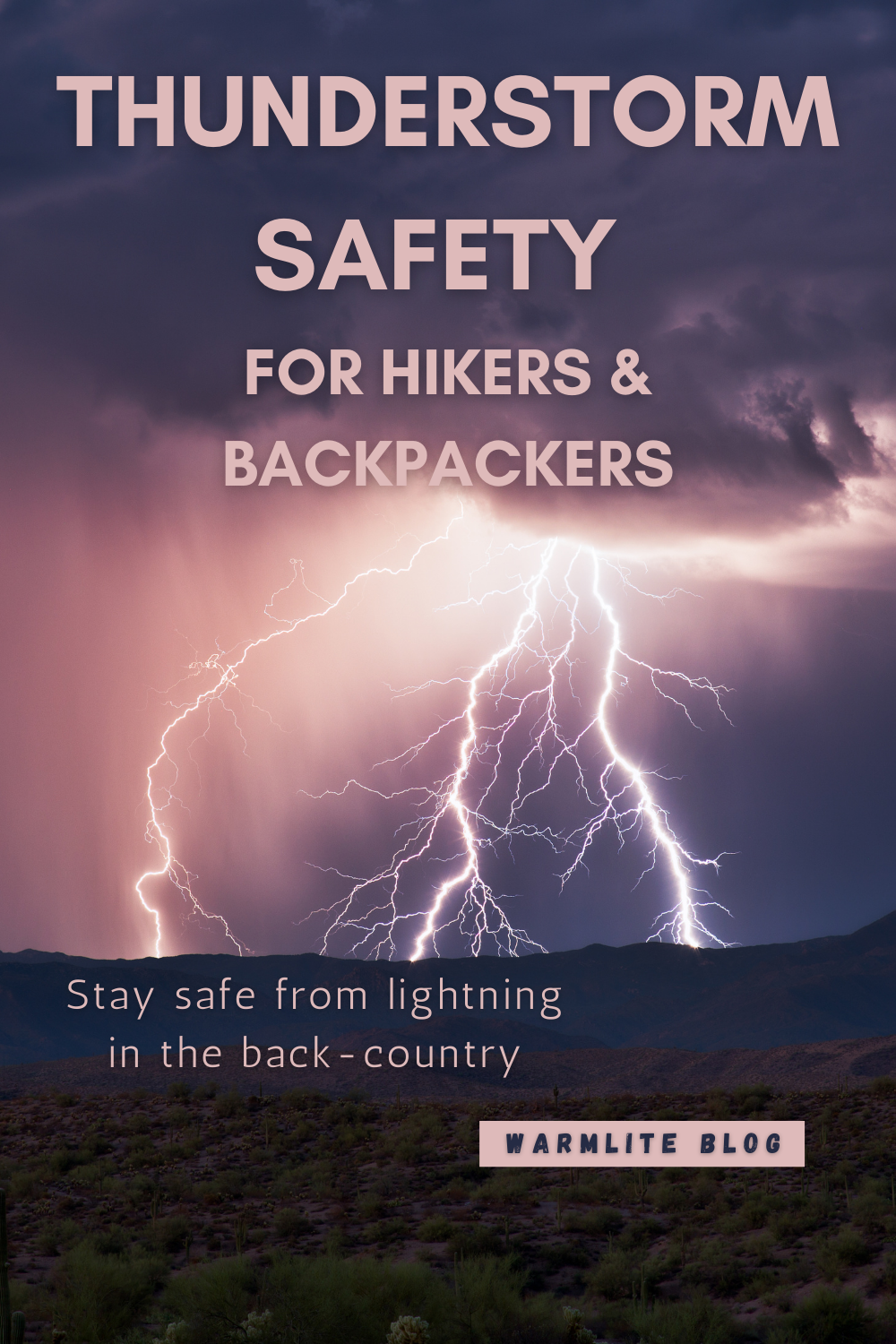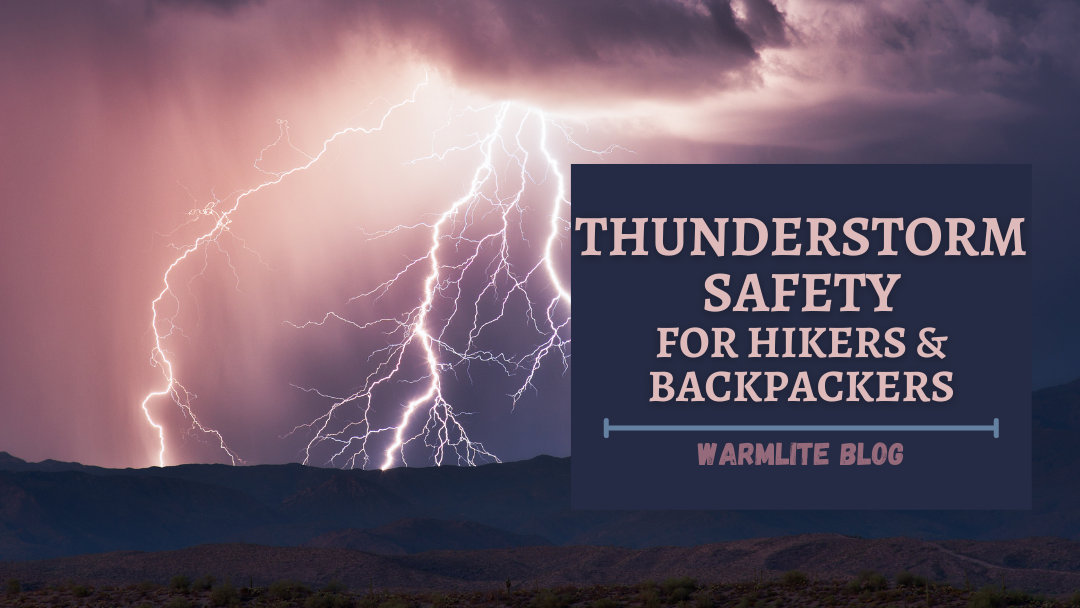Thunderstorm Safety for Hikers & Backpackers
By Jessica Marie
Introduction
With summer fast approaching, we will be seeing a steady increase in thunderstorms. While I love a good thunderstorm, they are best enjoyed from a safe place. They are so common that we often forget the very real dangers that can be wrought by a thunderstorm.
With any rain storm there is the chance for flash flooding, lack or loss of visibility, cooling temperatures, and strong winds. Each of these can pose a threat to a hiker or backpacker caught unaware or unprepared. Each can and do kill outdoor explorers each and every year. We often think of lightning as being far off in the distance, or we focus solely on the more immediate threats listed above. But lightning is just as dangerous and must be taken into account. Here we will talk about thunderstorm safety for hikers, backpackers and other outdoor explorers.
Avoid the storm
Before hiking or leaving on a backpacking trip it is always wisest to check the weather forecast. This will give you a better chance of knowing what to expect from your trip and can help you pack accordingly. Storms can roll in at any time of day, but they are most common in the afternoon. This is why many hikers start early, in an attempt to avoid the afternoon storms. But no matter the time of day, always be on the lookout for the signs of a coming storm. Stronger winds, cooling temperatures, the scent of rain, rain in the distance, darkening skies and clouds, thunder. The sooner you notice a potential storm the more time you have to adapt and find adequate shelter. Many GPS systems for hikers and climbers have NOAA weather alerts built into them and can help notify you of incoming storms. However, don’t rely solely on these technologies, always keep a look out for storms yourself.
Better Safe Than Sorry
Should you see a storm it is better to be safe than sorry. This is the time to turn back and seek shelter. Your tent is not the best shelter as the metal poles can conduct electricity and thus lightning. A fully functioning building (like a home, ranger station, store, etc.) or enclosed vehicle are the best places to seek shelter. Campground shelters and trail shelters can work in a pinch but do not truly offer protection from lightning.
A storm can be many miles away and you can still be struck by lightning. While it may be moving away from you or may not yet be here, lightning can strike beyond a storm system by up to 10 miles. Each year in the United States around 300 people are struck by lightning. Of those 300 around 30 die, and many survivors have lifelong injuries and disabilities. If you can hear thunder, you are close enough to be struck by lightning.
Make the best of the situation
If you miss the signs of a storm or decide to press on and get caught in a storm, what should you do? If you are near water, flee. Boats are not safe from a storm (unless they have a cabin and are properly built to disperse the lightning away from occupants. No canoe or kayak is safe.) Lakes, ponds, puddles, and oceans are all dangerous and you need to evacuate from them immediately.
Expert Advice
According to NOAA and the CDC these are your best options if you cannot get to a proper shelter. These are by no means safe, you can and may be struck by lightning even when following these guidelines. But these options may lessen your chances of being struck.
- Avoid open fields, the top of a hill or a ridge top. Immediately get off elevated areas such as hills, mountain ridges, or peaks.
- Stay away from tall, isolated trees or other tall objects. If you are in a forest, stay near a lower/shorter stand of trees. Never shelter under an isolated tree.
- If you are in a group, spread out to avoid the current traveling between group members. I have heard to stay upwards of 20 feet from each member in the party. This may increase the chances of someone being struck, but it can also decrease the chances that everyone or multiple people are struck. Allowing for remaining party members to provide first aid and call/seek help.
- Remember, a tent offers NO protection from lightning.
- Stay away from water, wet items, such as ropes, and metal objects, such as fences and poles. Stay away from objects that conduct electricity (barbed wire fences, power lines, windmills, etc.). Water and metal do not attract lightning but they are excellent conductors of electricity. The current from a lightning flash will easily travel for long distances.
- Never lie flat on the ground. Crouch down in a ball-like position with your head tucked and hands over your ears so that you are down low in minimal contact with the ground.
- Never use a cliff or rocky overhang for shelter.
- Immediately get out of and away from ponds, lakes, and other bodies of water.
- Fully enclosed buildings with wiring and plumbing are best. A hard-topped metal vehicle with the windows closed is also safe. Stay inside until 30 minutes after the last rumble of thunder. Sheds, picnic shelters, tents, or covered porches do NOT protect you from lightning.
- Remove metal from your person, trekking poles, metal framed packs, etc. and place them 20-100 feet away from you.
These are your best-case scenarios should you not be able to shelter indoors or in an enclosed vehicle.
Caves?
I have seen on several sites people suggesting to hide in a cave. I do not suggest this option as a very common hazard associated with storms are flash floods. You do not know the nature of the cave, it may fill with water. A bear or other animal may live inside and may not take kindly to you threatening their home. My suggestion is to avoid caves.
Conclusion
These are the best safety tips for surviving a lightning storm for hikers, backpackers, and other outdoor enthusiasts. Lightning storms can technically occur at any time of the year (snow storm lightning) but the highest occurrences of lightning strikes occur in the summer. Remember to check the weather, pay attention, and seek shelter as soon as possible. The commonality of thunderstorms desensitizes us to their danger, but it is a very real threat and must be taken seriously. Finally, stay inside until 30 minutes after the last rumble of thunder. Stay safe and come back next week when I talk about flash flood dangers and safety tips.



Recent Comments